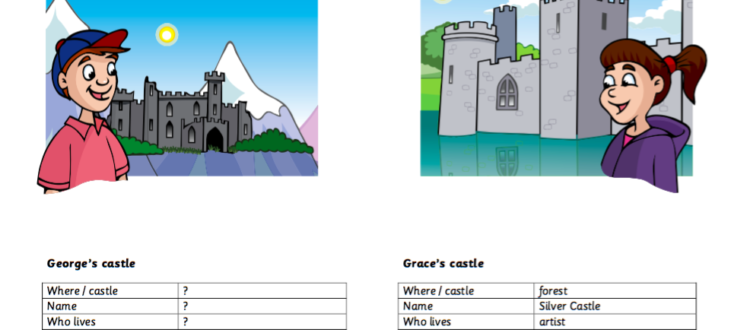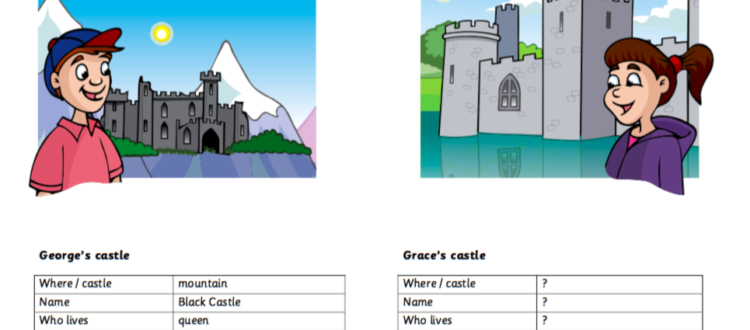How to do well in A2 Flyers Speaking Part 2
Following on from my previous post, I’ll share some tips for doing well in A2 Flyers Speaking Part 2.
Let’s look again at the A2 Flyers Speaking Part 2 from Sample Papers Volume 2 (available here: https://www.cambridgeenglish.org/Images/young-learners-sample-papers-2018-vol2.pdf :
The questions
There might be three types of questions to answer and ask:
Type 1: Wh- questions (starting with What, When, Where, Who, Why, How, How many, etc).
In the example, we can see that there are four Wh- questions. (Where is the castle? What’s the name of the castle? Who lives in the castle? How old is the castle?)
Tip 1: Train students to notice where there is (and isn’t) a /.
For these questions, we can see / in only the first one: Where/castle
The / indicates where words are missing and need to be added.
Where/castle > Where’s the castle?
The other two Wh- questions do not have a / .
Who lives
How old
So, no words need to be added BETWEEN these words (but after them, of course we need to add words to form the questions.)
Who lives > Who lives in the castle?
How old > How old is the castle?
Note: As we can see in this example, the Wh- word that the students need to use is not always written on the question paper.
Name > What’s the name of the castle?
They might read words like age or address or colour, etc.
Tip 2: Make sure that students know that for these kinds of question prompts, they will need to choose and use a question word:
Name > What‘s the name of the castle?
Colour > What colour is the bicycle?
Similarly, the question word might not be given, but the prompts are two ro three words long, e.g.
like/doing > What does George like doing?
time/open > What time does the castle open?
Tip 3: Train students to spot where the question is about the past.
Another thing to train students to think about (and spot when they listen to the examiner’s questions!) is if any of the questions should be in the past simple.
Let’s look at an example with a table I have created about Lucy’s bicycle.
| Colour | ? |
| Who bought | ? |
| Age | ? |
| When/get | ? |
| Cheap/expensive | ? |
For example:
When/get > When did Lucy get her bicycle?
Who bought > Who bought Lucy her bicycle?
In the question prompt: Who bought, the verb tells us that the question is in the past. So, normally, this would be an easier question to get right.
But in the question When/get , we don’t have a clue in the prompt.
Tip 4: Train students to look at the answers for words like ago or last.
| Colour | silver |
| Who/bought | uncle |
| Age | 8 years |
| When/get | 6 months ago |
| Cheap/expensive | cheap |
Words like ago or last will often appear in the answers to questions and will be in the table.
Others verbs to watch out for are gave, e.g.
Who/gave > Who gave Lucy the bicycle?
and start, e.g.
When/start > When did Lucy start cycling?
Type 2: Yes/no questions
Let’s go back to the questions about the castle.
In this example, the final question in the table is: Is the castle interesting.
Students don’t usually find these questions difficult to form or to answer.
Type 3: ‘or’ questions
We don’t have any examples here, but these could be questions like
Is the restaurant cheap or expensive?
Is the programme funny or scary?
Is the hotel big or little?
Is the concert loud or quiet?
Tip: Practise asking and answering questions using pairs of adjectives.
Tip 5: Practise intonation patterns with students, with the intonation rising after the first adjective and falling at the end of the question, on the second adjective.
And last, but not least, reassure students that the examiner will help them if they get stuck, by pointing at the information needed for the answer or to the prompt that they have not used to make a question.






Good site you have here.. It’s difficult to find quality writing like yours these days.
I honestly appreciate individuals like you! Take care!!